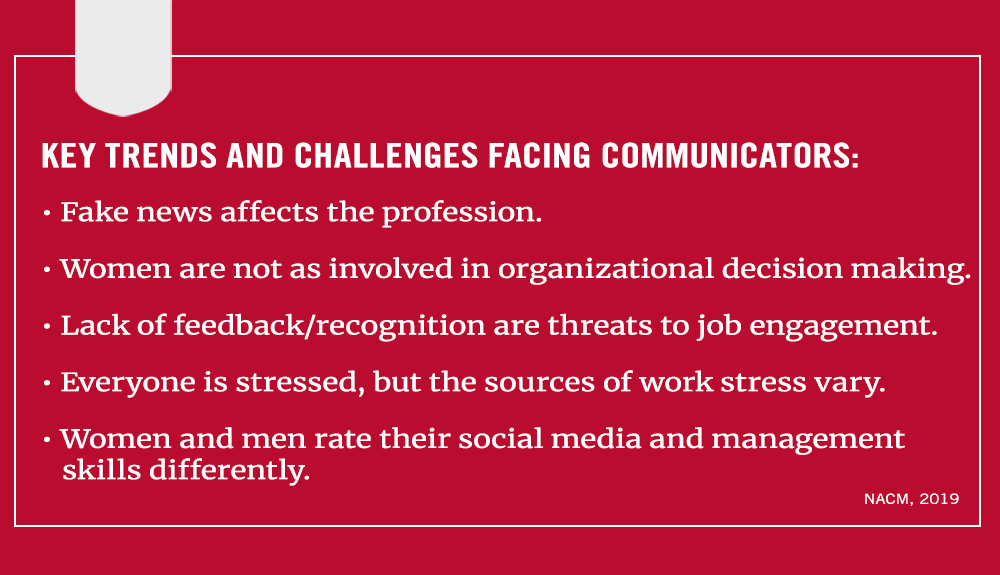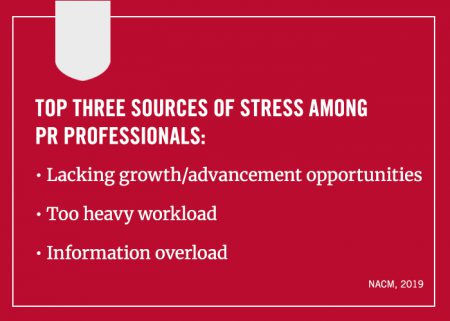Trends and challenges revealed in first North American Communication Monitor
Trends and challenges revealed in first North American Communication Monitor
The first study to examine the state of public relations in Canada and the United States found that building and maintaining trust is the most crucial issue facing the profession.
The North American Communication Monitor (NACM), conducted by The Plank Center for Leadership in Public Relations, was led by two Grady College faculty: Bryan Reber, the C. Richard Yarbrough Professor in Crisis Communication Leadership, and Juan Meng, associate professor of public relations. Reber was the lead researcher for the report and Meng was the lead analyst.
The NACM disclosed key trends and challenges facing the communication profession.
The results are based on responses from 1,020 communication professionals working in different types of organizations (255 in Canada and 765 in the United States). The sample achieved a balanced gender split (50% men and 50% women) for accurate comparisons. The average age of participants was 46.0 years.
Dr. Karla Gower, director of The Plank Center for Leadership in Public Relations, said, “Our goal with this study was to assess the state of the public relations field in North America and identify gaps, or opportunities to enrich the development of communication leaders. If we know where the gaps are, we can work to close them and to strengthen the overall quality of our profession’s leadership—a crucial strategic asset.”
The study, which joins existing Communication Monitors in Europe, Latin America and Asia-Pacific, explored diverse topics, including fake news and strategies to deal with it, top issues for the profession in the next three years, the role of providing information to support decision making, leaders’ performance, and professionals’ job engagement, trust in their organization, job satisfaction, work stress, and social media skills and management knowledge.
Reber said: “The Plank Center has embraced the opportunity to join a truly global network of researchers who regularly take the pulse of communication professionals to identify trends and opportunities. The North American Communication Monitor provides statistically reliable data to demonstrate professionals’ opinions and concerns and uses a nearly identical survey instrument as do the European, Latin American, and Asia-Pacific Communication Monitors. As a result, we are able to compare more than 6,000 responses across regions and cultures, the largest global data set for our profession.”
Fake news is a prominent issue but organizations lack processes to identify and manage it
Communication professionals agree fake news has become one of the most prominent issues in public discourse. More than half of surveyed professionals (57.7%) give attention to the on-going debate about fake news and consider it a much-debated topic in their country (68.2%). Results indicate governmental organizations across North America are particularly affected by fake news, with 20.9% being affected multiple times and 10.1% being affected once.
However, despite the high levels of awareness and attention to the debate about fake news, the level of relevance of fake news to the professionals’ daily work, and their concerns about it, are generally low. When it comes to identifying potential fake news, a substantial percentage of respondents (42.6%) said their organizations mainly rely on individual competencies and experience. Few organizations have in place policies, technical systems and processes to detect and manage fake news and misinformation.
Nearly half of the organizations (46.3%) do not share decision making with employees or members
The majority of surveyed professionals (71.9%) agree their top communication leader is actively involved in the organization’s decision making (78.1%) and demonstrates a strong ethical orientation to guide actions (76.7%). However, shared decision-making power receives the lowest rating across various types of organizations. Women rate the shared decision-making power significantly lower than men. A similar perceptual gap is identified along the line of hierarchy: Top communication leaders rate shared decision-making power significantly higher than team leaders and team members.
The major threat to job engagement is a lack of performance feedback and recognition, with a significant gender gap
The job engagement level is relatively high: 62.8% report they are engaged in their job. More than eight in 10 of surveyed professionals know what is expected of them at work (86.0%), and are in a positive environment where fellow employees are committed to quality work (81.3%). Professionals also said they have the opportunity to do what they can do best every day (79.1%) and their opinions count at work (75.3%). However, some are frustrated by the lack of feedback about their performance on the job (24.6%) and lack of recognition for doing good work (15.4%).
Though nearly three-quarters of communication professionals are satisfied with their job, the gender gap is big. Women (60.8%) report a much lower level of job satisfaction compared to men (70.2%).
Sources of work stress vary
One-third of surveyed professionals acknowledge they feel tense and stressed during a normal workday. Generally, the top three sources of stress are limited growth or advancement opportunities (34.3%), a too-heavy workload (33.6%), and information overload (33.3%). Top communication leaders are most stressed by information overload, team leaders by work overload, and team members by their lack of opportunity for growth and advancement. Women are most stressed by lack of advancement opportunities and heavy workload. Men are most stressed by information overload and being constantly available via email, text and phone.
Women and men rate their social media and knowledge management skills differently
Men and women see their knowledge and skill sets differently when coping with the digital evolution and social media. Women are more confident about delivering messages via social media (68.8%), identifying social media trends (55.7%), and setting up social media platforms (51.2%). Men are more confident of their understanding of the legal framework for social media (38.0%) and using algorithms to run analytics (35.7%).
When it comes to general management skills, men are significantly more confident, compared to women, about their abilities in strategic positioning, such as analyzing overall organizational goals, scenario planning, and linking communication to business agendas. Men also report higher scores on managing human and financial resources.
“The depths and the variety of investigated topics presented by this year’s NACM help us better understand the communication industry in North America,” Meng said of the report. “More importantly, our rich results will deliver crucial insights to inform effective practice for communication professionals at all levels, from top leaders to team leaders and team members, as they all need to tackle these challenges now or in the near future.”
To download and read the NACM 2018-2019 full report, please visit the Plank Center’s website.


